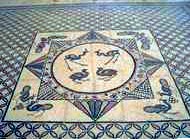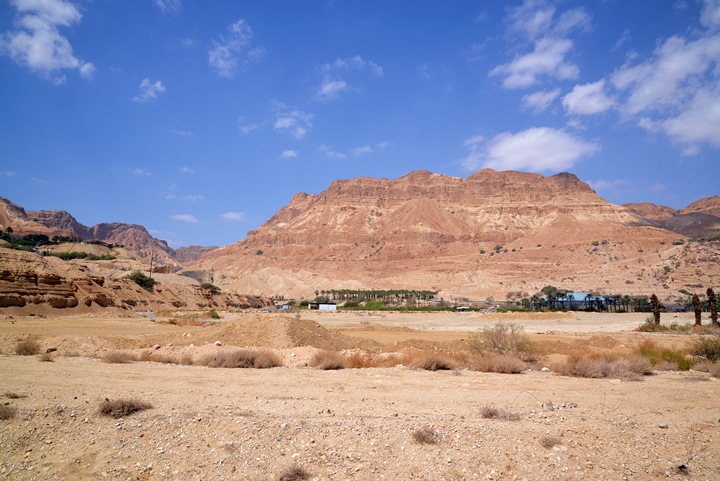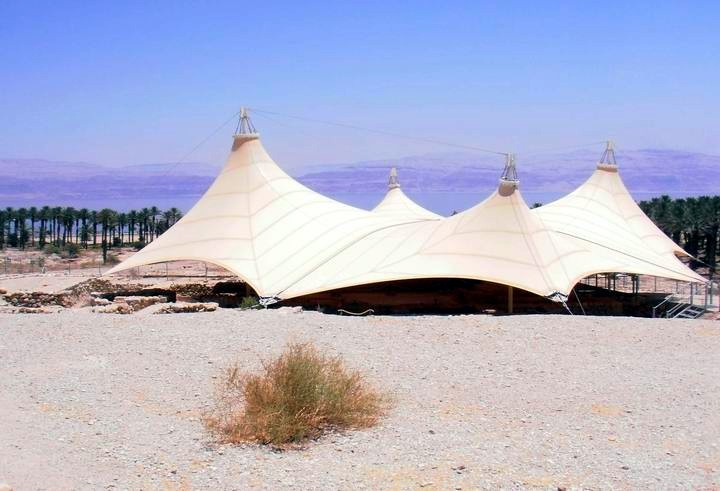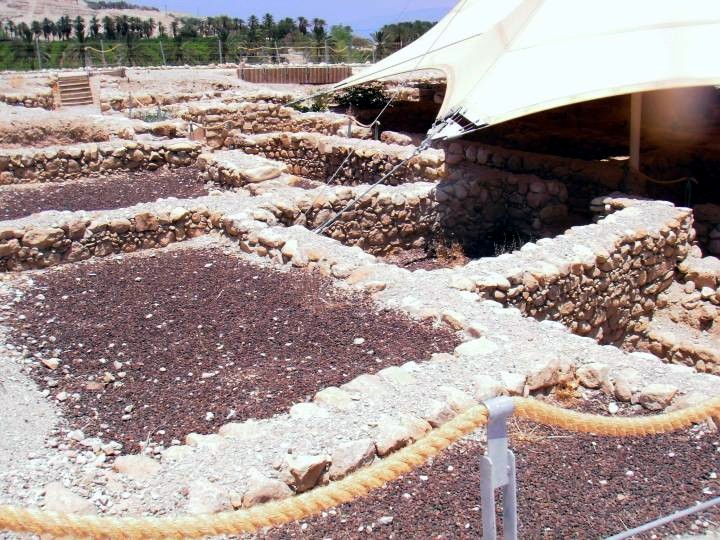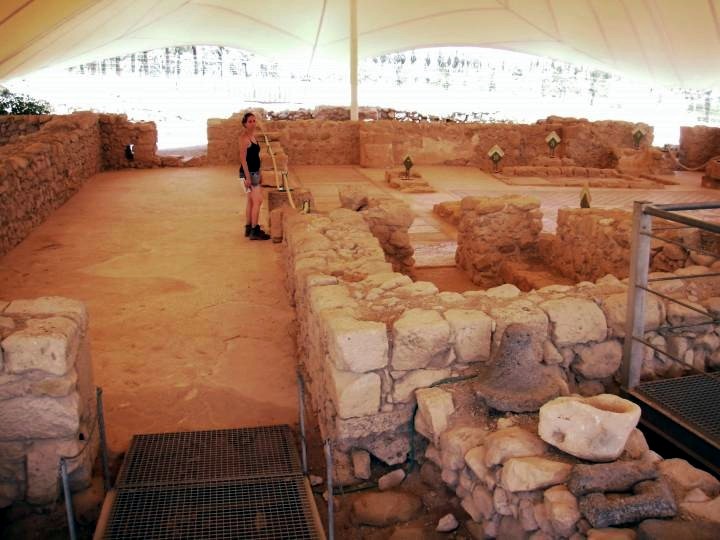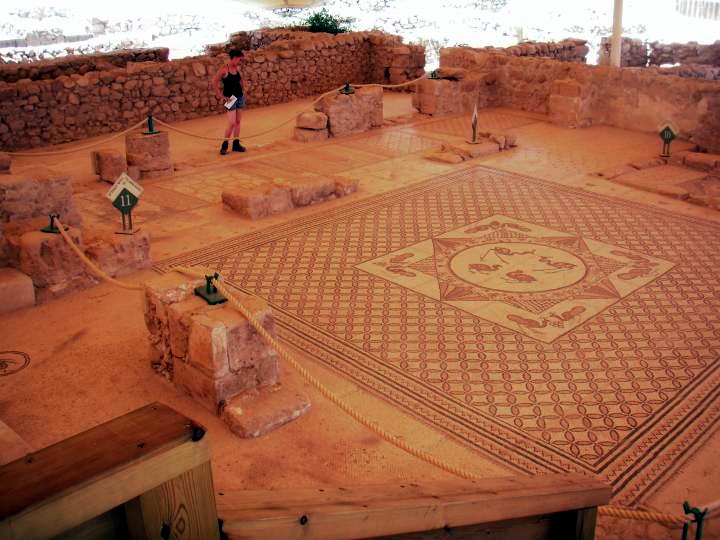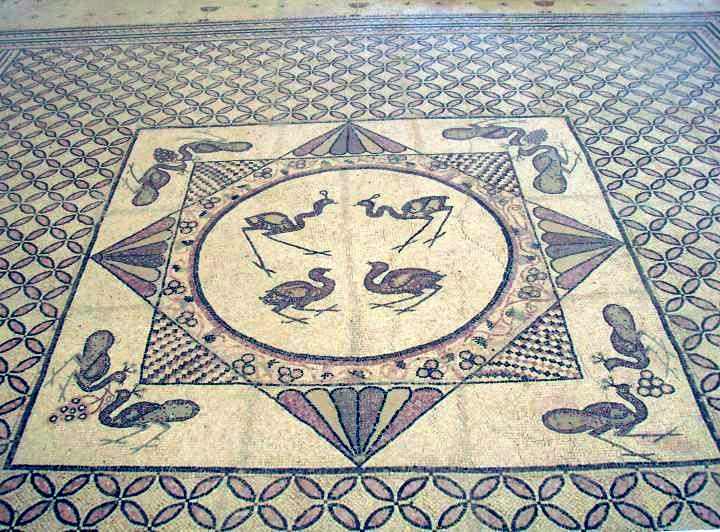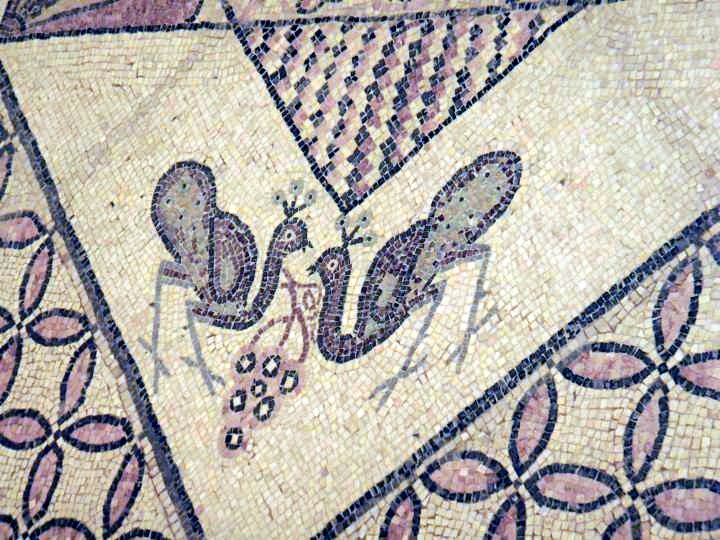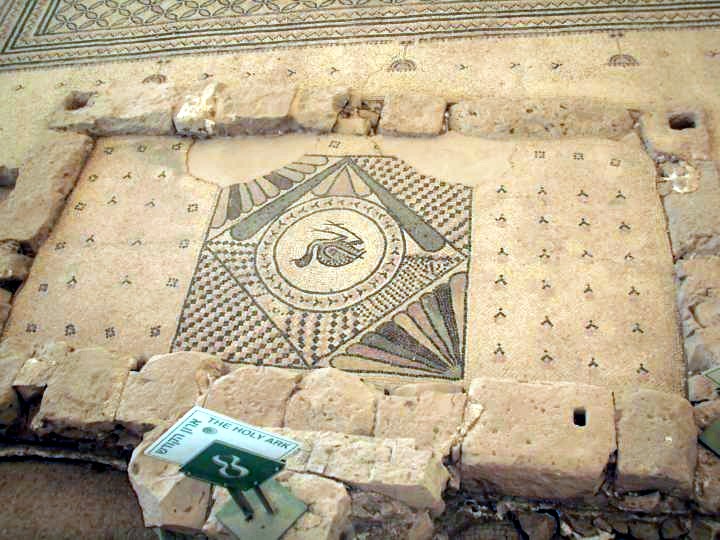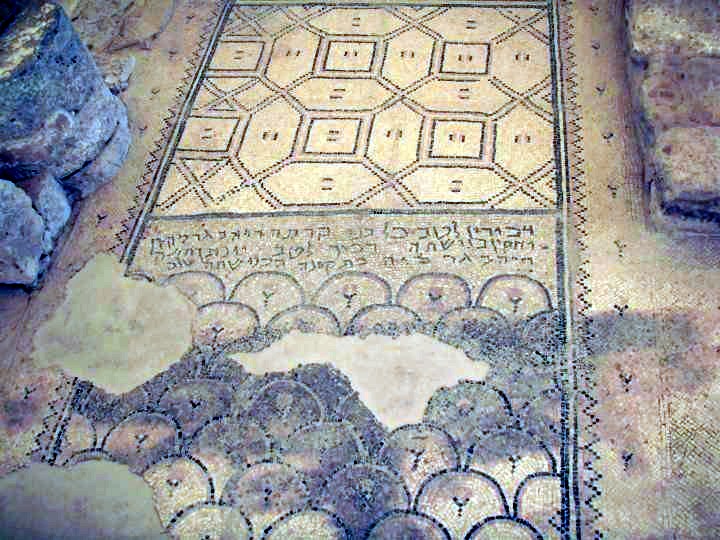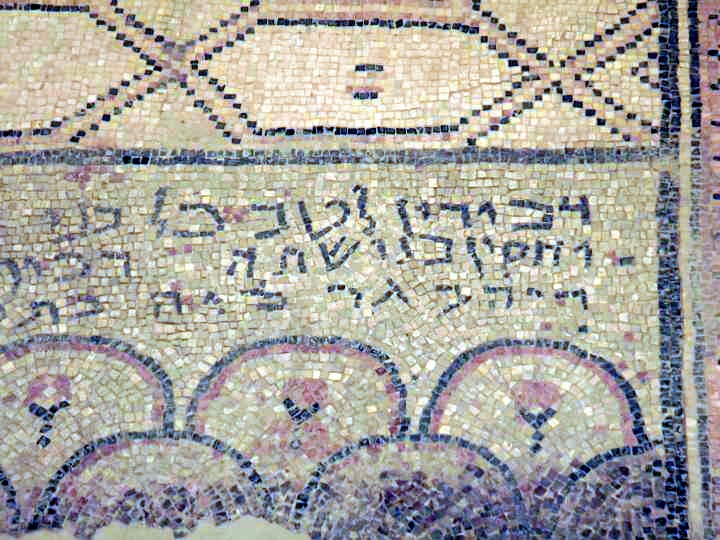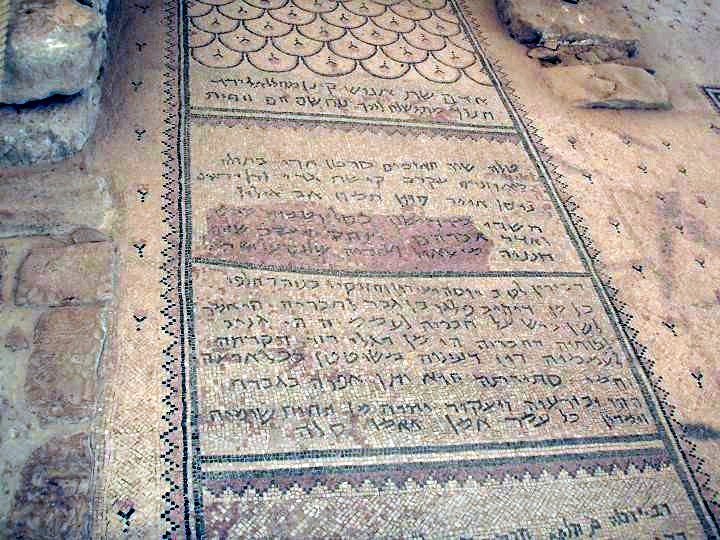An oasis located on the western shore of the Dead Sea. A prosperous town, famous for its fertile land, dates and persimmon perfume.
Home > Sites > Dead Sea > Ein-Gedi
Contents:
Background
Location
Photos
Biblical
References
Etymology
Links
Overview:
Ein Gedi is an oasis and nature reserve located in the Judean Desert, near the Dead Sea in Israel. The site has a long and rich history, dating back to ancient times. It is mentioned in the Bible as one of the places where David took refuge from Saul (1 Samuel 23 29): “And David went up from thence, and dwelt in strong holds at Engedi“.
The ancient city of Ein Gedi was a thriving center of agriculture and commerce during the Roman and Byzantine periods. The city was known for its production of balsam, a valuable perfume and medicine that was highly prized in the ancient world. The balsam (persimmon, Hebrew: afarsemmon) was grown in the nearby botanical gardens and processed in the city’s factories.
The city was also a center of Jewish scholarship and mysticism. According to tradition, Rabbi Shimon bar Yochai, one of the most important figures in Jewish mysticism, spent time in Ein Gedi studying and teaching.
Ein Gedi is the largest desert oasis in Israel (1,000 dunams – 250 acres). It is watered by four springs. Its fresh waters made the settlement possible since ancient times, and was referred several times in the Bible as a fertile place.
Today, visitors can explore the ancient ruins of Ein Gedi, including the remains of the city’s synagogue, which dates back to the 3rd century AD. They can also hike in the nature reserve, which is home to a variety of plants and animals, including ibexes, hyraxes, and a wide variety of birds.
Location:
Ein Gedi is located 50KM south east of Jerusalem, 16KM north of Masada. An aerial map of the area of Ein-Gedi is shown below, indicating the major points on interest.
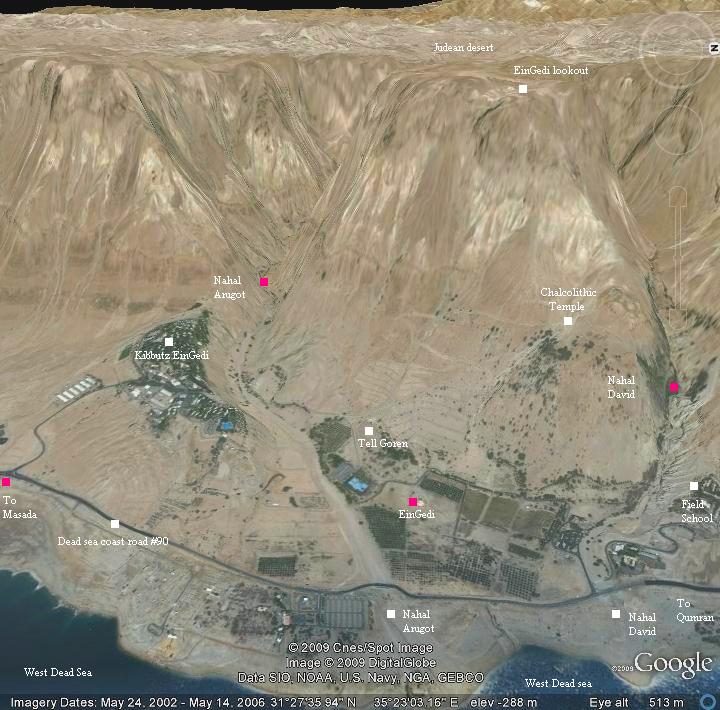
History:
-
Prehistoric periods
Ein Gedi was inhabited starting from the Chalcolithic period (5,000 years ago), in places along the streams around Ein Gedi. A temple from that period was excavated on the hill above Ein Gedi spring.
-
Biblical periods (Iron age)
The site was known in the Biblical times as fertile, blessed by the spring it is named after. This area is where David hid from the pursuing King Saul (1 Samuel 23 29: “And David went up from thence, and dwelt in strong holds at Engedi“).
Ancient Ein Gedi is located on Tel Goren, a low hill (size of 2 dunam – 1/4 acre) on the north bank of Nahal Arugot. It was established as a small village in the 7th century BC, during the Judean Kingdom. A seal was found bearing the name “Uriyahu son of Azaryahu”, perhaps belonging to an official Judean clerk around the 6th-7th century BC.
The village thrived during the next 14 centuries, expanding into a small city which was located around and near the ancient site. A small harbor was located in Ein Gedi, and wood and stones anchors were found here on the eastern side of the synagogue. At some times the water level reached and flooded the houses of Ein Gedi.
-
Persian/Hellenistic/Hasmonean period
The Babylonians destroyed the village (located on Tel Goren) in the 6th century BC (~582 BC). It was repopulated after the exiles return during the Persian period (~440 BC). The village continued until the 4th century, then was deserted.
The Hasmonean Kings, starting from Hyrcanus I (134-104 BC) and especially Alexander Jannaeus (103-76), rebuilt the oasis, marking the rise of the new Ein Gedi. They added aqueducts and pools, initiated the balsam (persimmon) industry, planted trees on the hillsides, and relocated the new village to the north of Tel Goren.
-
Roman period
The village of Ein Gedi reached its peak during the Roman/Byzantine period, and was a wealthy town, famous for its dates and rare perfume, which could only be grown in few sites on the Dead Sea shore. The new Ein Gedi relocated north-east from Tel Goren, to a ridge between Arugot and David streams, and expanded to 40 dunams (10 acres) – one of the largest villages. The village was densely built, with houses connected to each other. A 2nd century AD Roman bathhouse complex (40 x 5M) was excavated on the sea shore, north-east of the city.
Ein Gedi was damaged during the first and second revolts against the Romans (70, 132 AD), but survived after a short time. During the first revolt, the village was sacked by their fellow zealot Jews from Masada, who filled up their storerooms with the booty from the village.
-
Byzantine period
A grand synagogue was excavated inside the ruins of the town. The present structure is dated to the 5th century AD and based on earlier structures starting from the beginning of the 3rd century.
The synagogue was destroyed by fire in the middle of the 6th century, during the period of Justin II. Thus came an end of 1,000 years of civilization in the Ein Gedi oasis, and remained in ruins since then.
-
Mamelukes, Ottoman and British
In the Mameluke period, during the 13th-14th century, some of the ruined houses were used for temporary residence, the village never overcame the destruction. During the late Ottoman period there were several Bedouin families in Ein Gedi that grew vegetables.
-
Modern times
Ein Gedi became part of the newly founded Israel since 1949. A kibbutz was established in 1953, named Ein Gedi, on the south side of Nahal Arugot. Being located in the Dead sea depression, it was the lowest agriculture farm in the World (320 under sea level, and 80M above Dead Sea level). A nature reserve field school – the first of its kind in Israel – was established in 1960 on the north side of Nahal David, which was located until 1967 on the border with Jordan.
Ein Gedi became since then a regional center and base for nature hikes, camping and swimming.
-
Archaeological surveys and excavations
Tel Goren, the site of the Biblical town, was surveyed in the 1875 PEF survey. The Tel was excavated during 1961-1965 (B. Mazar). The adjacent Byzantine period synagogue was excavated in 1970-1972 (Barag and Porath). Extensive excavations, covering only 10% of the Roman/Byzantine village, were conducted by Hirschfeld (1996-2002 ) and Gidon Hadas (2003-2005).
Photos:
(a) General view:
A view of the area of Ein Gedi is seen here, from the main road along the coast of the Dead Sea. The Kibbutz of Ein Gedi is on the left, located on a hill overlooking the Arugot brook. In the background are the high mountains of the Judean desert, at an altitude of 150m above sea level, or 450m above the Dead Sea level. On the right side are the ruins of ancient Ein Gedi.
Click on the photos to view in higher resolution…
All following synagogue photos by Tuvia & Shachar Liran.
(b) Synagogue:
The synagogue is located on the north-east side of Tell Goren. It was first built in the 3rd C AD as a modest structure. The structure underwent a series of renovations during the 4th C and 5th C. It had two floors, with a staircase on its northwest wall.
A tent, seen below, covers the area of the synagogue to preserve the findings.
The residential structures around the synagogue are seen below. The Roman/Byzantine village was densely built, with houses connected to each other. Some of the rooms seen below may have served the synagogue’s staff.
Under the protective tent is the large (16 x 13M) synagogue, which was rebuilt in the 5th century. The front of the structure is directed to the north – towards Jerusalem.
The synagogue pillars and walls were covered by plaster and painted with color. The floor was covered by a beautiful mosaic carpet.
(c) Synagogue Mosaics:
The floor of the synagogue is covered by a beautiful mosaics. Most of the mosaic carpet is decorated with quad petal flowers. In the center is a circle with four birds. The circle is framed by two squares, with a pair of peacocks on each corner.
A detail of one of the corners is seen below, with a pair of peacocks eating grapes.
The Torah Ark was placed in front of the north wall, and a rectangular bimah (platform for the torah reading) was installed. At the bimah is a small mosaic section (seen below), depicting a peacock in the center of a circle, framed by a square with geometric forms. Three small figures of the seven branched menorah (candelabrum) are seen in front of the bimah. A hoard of 5,000 coins, a tall bronze menorah, and other artifacts, were found hidden in a niche near the ark. The coins were dated up to Justin II (565-578), which date when the synagogue was torched.
Inscriptions in Hebrew and Aramaic list the donators who helped to construct and renovate the synagogue.
A detail of the Aramaic inscription from above is seen below. It starts with “Remembered for good…”, a common prefix found in most Roman/Byzantine synagogue floors.
A unique inscription with 18 lines contained within 4 long tablets. The inscription is seen in the photo below, and is translated from Hebrew/Aramaic:
Line Translated inscription
- 1-2: a list of generations from Adam to Japeth, according to 1 Chronicles 1 1-4: Adam, Seth, Enosh, Kenan, Mehalalel, Jared, Enoch, Methuselah, Lamech, Noah, Shem, Ham and Japheth.
- 3-4: the signs of the Zodiac (Hebrew names)
- 5-6: A list of the 12 Hebrew months
- 7: A list of the patriarchs ( “Abraham, Isaac and Jacob”)
- 8: The names of the three companions of Daniel (Hananiah, Mishael and Azariah) and a blessing ( “peace on Israel”).
- 9: A list of private donors.
- 10-12: A warning: “Warnings to those who commit sins causing dissension in the community, passing malicious information to the gentiles, or revealing the secrets of the town.” The secrets of the town refers to the perfume production which made this town so wealthy, and the inscription warned against revealing it to the gentiles.
- 13-16: A curse to the warned: “The one whose eyes roam over the entire earth and sees what is concealed will uproot this person and his seed from under the sun and all the people will say, Amen. Selah.”
- 17-18: The last 2 lines also list private donors, ending with Shalom (peace)
(d) Tel Goren
Ancient Ein-Gedi started on Tel Goren, situated on a low hill on the north bank of Nahal Arugot. It was established as a small village in the 7th century BC, during the Judean Kingdom. The village thrived during the next 14 centuries, expanding into a small city which was located around and near the ancient site.
![]() Visit Tel Goren in a separate web page.
Visit Tel Goren in a separate web page.
Biblical References:
There are many references in the Bible on Ein Gedi:
(a) 1 Samuel 23 29, 24:1
Ein-Gedi was the place where David hid while being pursued by King Saul:
“And David went up from thence, and dwelt in strong holds at Engedi“.
“And it came to pass, when Saul was returned from following the Philistines, that it was told him, saying, Behold, David is in the wilderness of Engedi“.
(b) Song of Solomon 1:14
The vineyards of Ein Gedi (EnGedi) were celebrated in King Solomon’s times:
“My beloved is unto me as a cluster of camphire in the vineyards of Engedi“
(c) Ezekiel 47 10:
This verse is an optimistic prophecy of the Dead sea becoming live again, with abundant fish in its waters. Note that Eneglaim may be an ancient city where Qumran is located.
“And it shall come to pass, that the fishers shall stand upon it from Engedi even unto Eneglaim; they shall be a place to spread forth nets; their fish shall be according to their kinds, as the fish of the great sea, exceeding many”.
(d) 2 Chronicles 20 2
This verse describes the location of Ein Gedi, since Hazazon means “the middle” (of Dead Sea) and Tamar is the area of the Dead Sea (the name of the council that includes Ein Gedi). It is also referred in Genesis 14 7 as the area of the Amorites.
“Then there came some that told Jehoshaphat, saying, There cometh a great multitude against thee from beyond the sea on this side Syria; and, behold, they be in Hazazontamar, which is Engedi“.
Josephus Flavius:
(a) Antiquities IX 2
This text adds more to the text in 2 Chronicles 20, adding that Ein Gedi grows the best kind of dates and balsam (Balsam/Opobalsamum was used to produce a particular type of perfume).
“About the same time the Moabites and Ammonites made an expedition against Jehoshaphat, ,and took with them a great body of Arabians, and pitched their camp at Engedi, a city that is situate at the lake Asphaltiris, and distant three hundred furlongs from Jerusalem. In that place grows the best kind of palm trees, and the opobalsamum”.
(b) Wars IV 7 2
In 67AD, during the Great Revolt, The Sicarii from Masada sacked the village of Ein Gedi on Passover eve, killing 700 and ousting the rest.
“…they came down by night, without being discovered by those that could have prevented them, and overran a certain small city called Engaddi:–in which expedition they prevented those citizens that could have stopped them, before they could arm themselves, and fight them. They also dispersed them, and cast them out of the city. As for such as could not run away, being women and children, they slew of them above seven hundred. Afterward, when they had carried every thing out of their houses, and had seized upon all the fruits that were in a flourishing condition, they brought them into Masada. And indeed these men laid all the villages that were about the fortress waste, and made the whole country desolate; while there came to them every day, from all parts, not a few men as corrupt as themselves”.
Etymology (behind the name):
- Ein Gedi – Hebrew: Ein-spring, Gedi – Kid (a young goat). Prof Mazar suggested that Gedi is based on “Gedud” which means “many”, and translates Ein Gedi to “many springs” – based on the four springs of the site which give it life in this dry area.
- Ain Jidy (A’in Jidi) – the Arabic name of Ein Gedi (as in PEF maps); preserved the ancient name
-
Balsam – the balsam plant (persimmon, Hebrew: afarsemmon) was extracted to produce perfume. This rare plant grew only in few sites along the Dead Sea, and its process was a secret, which was lost after the Byzantine period. In modern Hebrew “perfume” is “Bosem”, which was the source of the name of balsam, but in the Biblical texts it refers to the plant.
In Songs of Songs (Songs of Solomon) the word Bosem is found in several verses, which was translated in KJV to spices: (5 1): “I have gathered my myrrh with my spice“, (5:13): “His cheeks are as a bed of spices“. The next verses is a popular Hebrew song (6 2):”My beloved is gone down into his garden, to the beds of spices, to feed in the gardens, and to gather lilies”.
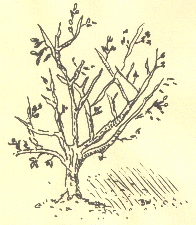
Links:
* External links –
- Ein Gedi – A large Jewish village – Y. Hirschfeld – summary of seven years of excavations (1996-2002 )
- Ein Gedi 2006 – Arch News 118 p 353-358 (G. Hadas; pdf )
- The secret of the precious Balsam (Hebrew; pdf)
* Internal – Sites around Ein Gedi:
* Aerial views (Youtube channel by BibleWalks.com)
BibleWalks.com = Touring the Bible Land
Nahal David<<<—previous site—<<< All Sites >>>—next Dead Sea site—>>> Tel Goren
This page was last updated on Apr 7, 2023 (new overview)
Sponsored links:
